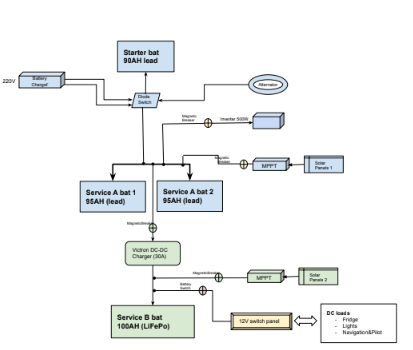Hi all
I am adding a LFP4 battery to increase the battery house capacity of my boat (Dufour, 38ft, 2014). I would like to hear opinions about the setup I am considering
Current setup (mostly factory set-up)
- 1 Starter battery (FLA), 90AH
- 2 House batteries (FLA), 95AH
- 1 AC battery charger connected to Starter and House banks (independently) - 25A
- Mitsubishi 125A alternator (Volvo D2-40)
- 1 MPPT (100V/20A), connected to House batteries
- 1 Victron Inverter (500W)
Needs
I would like to add 1 additional LFP4 battery (Victron). Probably 100AH or 150AH
- reducing to the minimum the changes to the existing wiring
- since current house batteries are quite new, if possible I would like to keep using them
Plan
My plan is to maintain the current setup as much as possible, with the following changes:
- add the new LFP4 battery to the existing house bank, connected thru a Victron Orion-TR Smart DC-DC charger
- add a new Victron MPPT (100/20A), connected to the new LFP4, since I intend to install additional solar panels
- move all "services loads" (fridge, navigation, lights, etc) to the LFP4. This implies basically moving a single cable to the new battery (though a new busbar)
- I will keep the existing Victron Inverter and MPPT attached to the FLA bats
This is the simplified schema (no cabling, busbars, etc)

This setup is somewhat different to the usual scenario of a Victron Orion-TR, in which the LFP4 battery charges from the Start battery (and LFP4 becomes the single house battery)
I have read extensively all the info about DC-DC chargers in this forum (and other sailing community forums) and could not figure out any significant issue, but obviously I am not an expert. Any remark about this configuration?
Any remark about where to place the MPPTs? I am assuming that splitting my solar charging to both environments (FLA and LFP4) makes sense (in order to maximize energy storage), but I am not sure if this would have significant drawbacks. I acknowledge that I will need to find suitable voltage levels when programming the DC-DC charger so that I the charging of the batteries in the different scenarios (day/night sailing, motoring, connected to port, etc)
Thanks in advance and apologies for the long message
